BUS500: Leadership Analysis - Woolworths Supermarket Report
VerifiedAdded on 2022/11/25
|14
|3879
|401
Report
AI Summary
This report provides a comprehensive analysis of leadership practices within Woolworths Supermarket. It begins with an introduction to leadership concepts and defines leadership in the context of business organizations. The report then provides an overview of Woolworths, detailing its operations and market position, followed by an in-depth examination of leadership practices, particularly focusing on the participative leadership style employed by the company. It explores the strengths of this approach, such as employee morale and improved communication, as well as its weaknesses, including slow decision-making and potential conflicts. The report also discusses challenges faced by Woolworths, such as employee turnover and innovation. Finally, it offers recommendations for improving leadership performance and overall organizational effectiveness, concluding with a summary of the key findings and insights into the impact of leadership on the company's success.
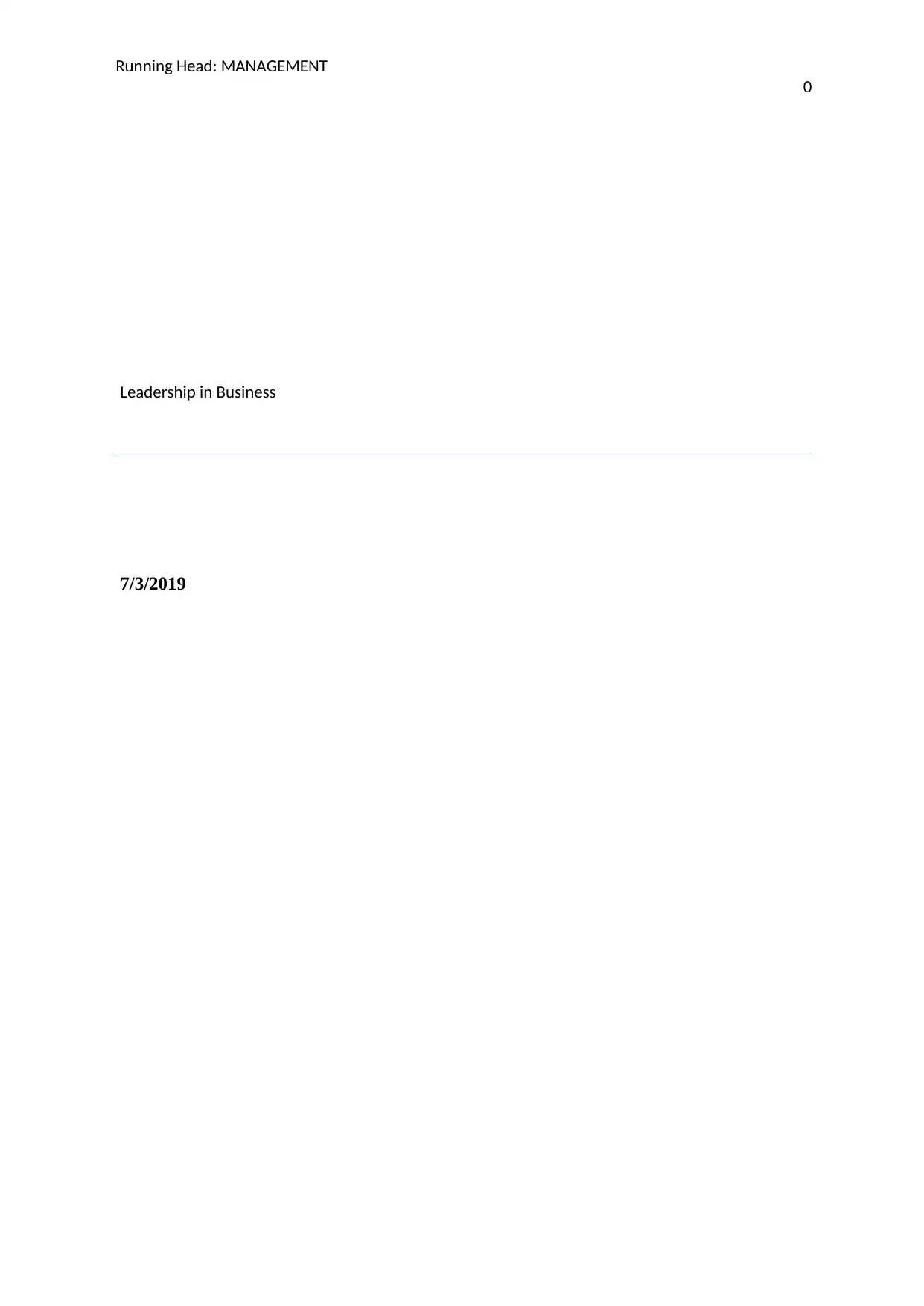
Running Head: MANAGEMENT
0
Leadership in Business
7/3/2019
0
Leadership in Business
7/3/2019
Paraphrase This Document
Need a fresh take? Get an instant paraphrase of this document with our AI Paraphraser
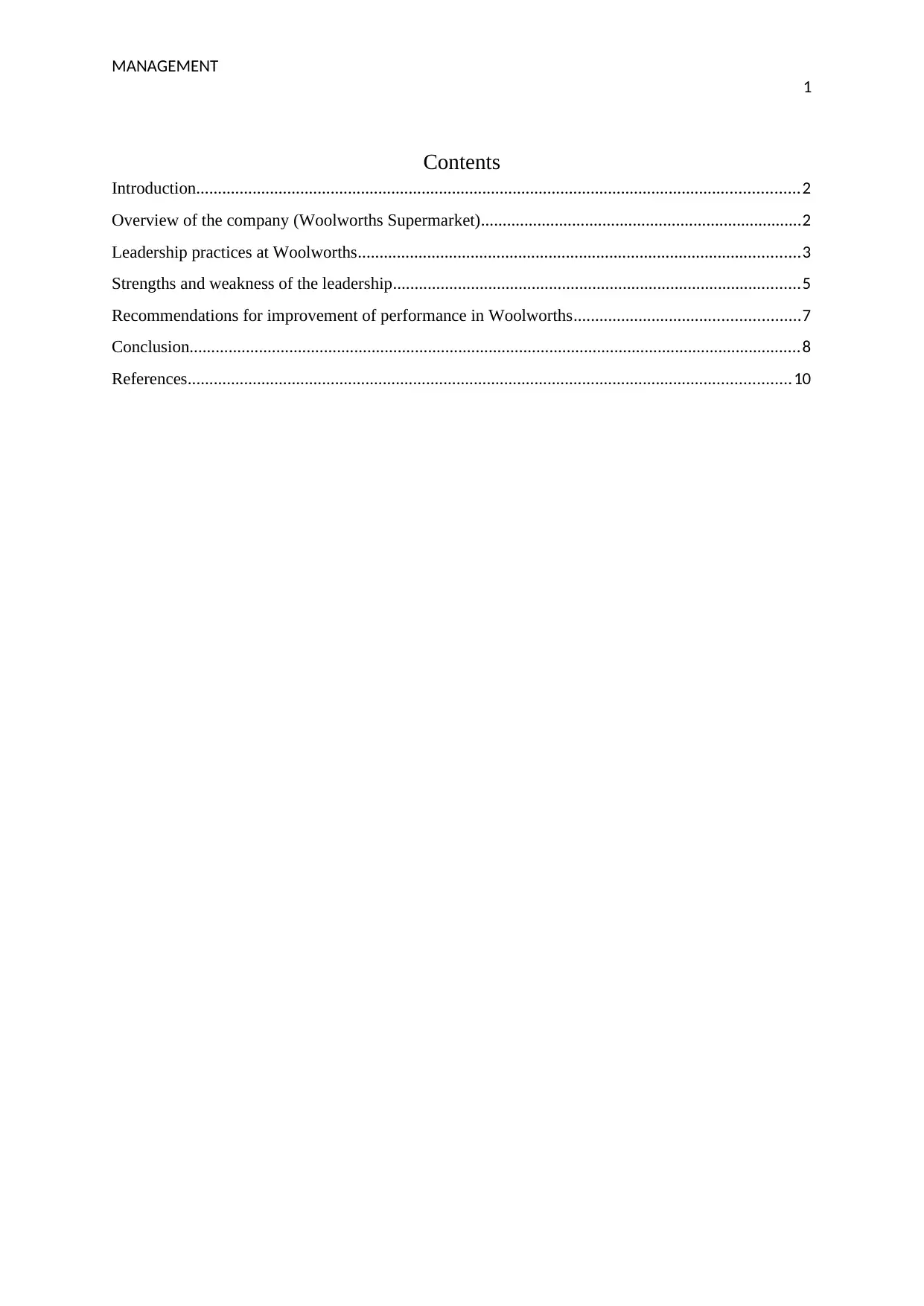
MANAGEMENT
1
Contents
Introduction...........................................................................................................................................2
Overview of the company (Woolworths Supermarket)..........................................................................2
Leadership practices at Woolworths......................................................................................................3
Strengths and weakness of the leadership..............................................................................................5
Recommendations for improvement of performance in Woolworths....................................................7
Conclusion.............................................................................................................................................8
References...........................................................................................................................................10
1
Contents
Introduction...........................................................................................................................................2
Overview of the company (Woolworths Supermarket)..........................................................................2
Leadership practices at Woolworths......................................................................................................3
Strengths and weakness of the leadership..............................................................................................5
Recommendations for improvement of performance in Woolworths....................................................7
Conclusion.............................................................................................................................................8
References...........................................................................................................................................10

MANAGEMENT
2
Introduction
The report will discuss the management concepts, and practices or issues of
leadership in context to business organisations. In general words, leadership can be defined
as the process of impacting the attitude or behaviour of individuals towards the attainment of
common goals. The role of leaders or managers is considered crucial to lead the employees
or individuals towards their goals, and development. In this report, ‘Woolworths
Supermarket’ has been undertaken as the organisation to analyse leadership practices. The
discussion will explain leadership styles, practices, and challenges faced by leaders or
managers in Woolworths. The report will also determine a difference between leadership
influence and coercion applied on the members of organisation. These will be demonstrated
with concept of power & authority, playing a major role in organisational effectiveness.
Woolworth’s leadership style will also be mentioned in the report, along with the strengths
and limitations, determining the level of performance. In the later part, recommendations in
relation to the leadership practice will be provided to bring change or improvement in the
future years. The readers will acquire an understanding of leadership practices and the
influence on the functioning and growth of organisation. Thus, these concepts and leadership
practices, or behaviours will be illustrated with the help of suitable examples and appropriate
literature.
Overview of the company (Woolworths Supermarket)
Woolworths is an Australian supermarket grocery store that is managed and governed
by Woolworths Group. The supermarket is a part of the retail sector, and specialises in the
sale of groceries i.e. vegetables, fruits and other food items. In addition to the eatables, the
company also sell DVDs, magazines and other items. The core business of the company, is
Supermarket, Woolworths Groups is the largest liquor take away retailer in Australia. The
company has acquired a major share i.e. 80% of the retail market within the country, and
continue to attract large number of customers across the nation. The store outlets of the
Woolworths mainly operate using the green apple logo, which serves to determine one of the
best retailer in the industry (Woolworths, 2018).
Working as the grocery store chain, maintaining the health and satisfaction of their
customers is the core objective of Woolworths. Effective management practices and
2
Introduction
The report will discuss the management concepts, and practices or issues of
leadership in context to business organisations. In general words, leadership can be defined
as the process of impacting the attitude or behaviour of individuals towards the attainment of
common goals. The role of leaders or managers is considered crucial to lead the employees
or individuals towards their goals, and development. In this report, ‘Woolworths
Supermarket’ has been undertaken as the organisation to analyse leadership practices. The
discussion will explain leadership styles, practices, and challenges faced by leaders or
managers in Woolworths. The report will also determine a difference between leadership
influence and coercion applied on the members of organisation. These will be demonstrated
with concept of power & authority, playing a major role in organisational effectiveness.
Woolworth’s leadership style will also be mentioned in the report, along with the strengths
and limitations, determining the level of performance. In the later part, recommendations in
relation to the leadership practice will be provided to bring change or improvement in the
future years. The readers will acquire an understanding of leadership practices and the
influence on the functioning and growth of organisation. Thus, these concepts and leadership
practices, or behaviours will be illustrated with the help of suitable examples and appropriate
literature.
Overview of the company (Woolworths Supermarket)
Woolworths is an Australian supermarket grocery store that is managed and governed
by Woolworths Group. The supermarket is a part of the retail sector, and specialises in the
sale of groceries i.e. vegetables, fruits and other food items. In addition to the eatables, the
company also sell DVDs, magazines and other items. The core business of the company, is
Supermarket, Woolworths Groups is the largest liquor take away retailer in Australia. The
company has acquired a major share i.e. 80% of the retail market within the country, and
continue to attract large number of customers across the nation. The store outlets of the
Woolworths mainly operate using the green apple logo, which serves to determine one of the
best retailer in the industry (Woolworths, 2018).
Working as the grocery store chain, maintaining the health and satisfaction of their
customers is the core objective of Woolworths. Effective management practices and
⊘ This is a preview!⊘
Do you want full access?
Subscribe today to unlock all pages.

Trusted by 1+ million students worldwide
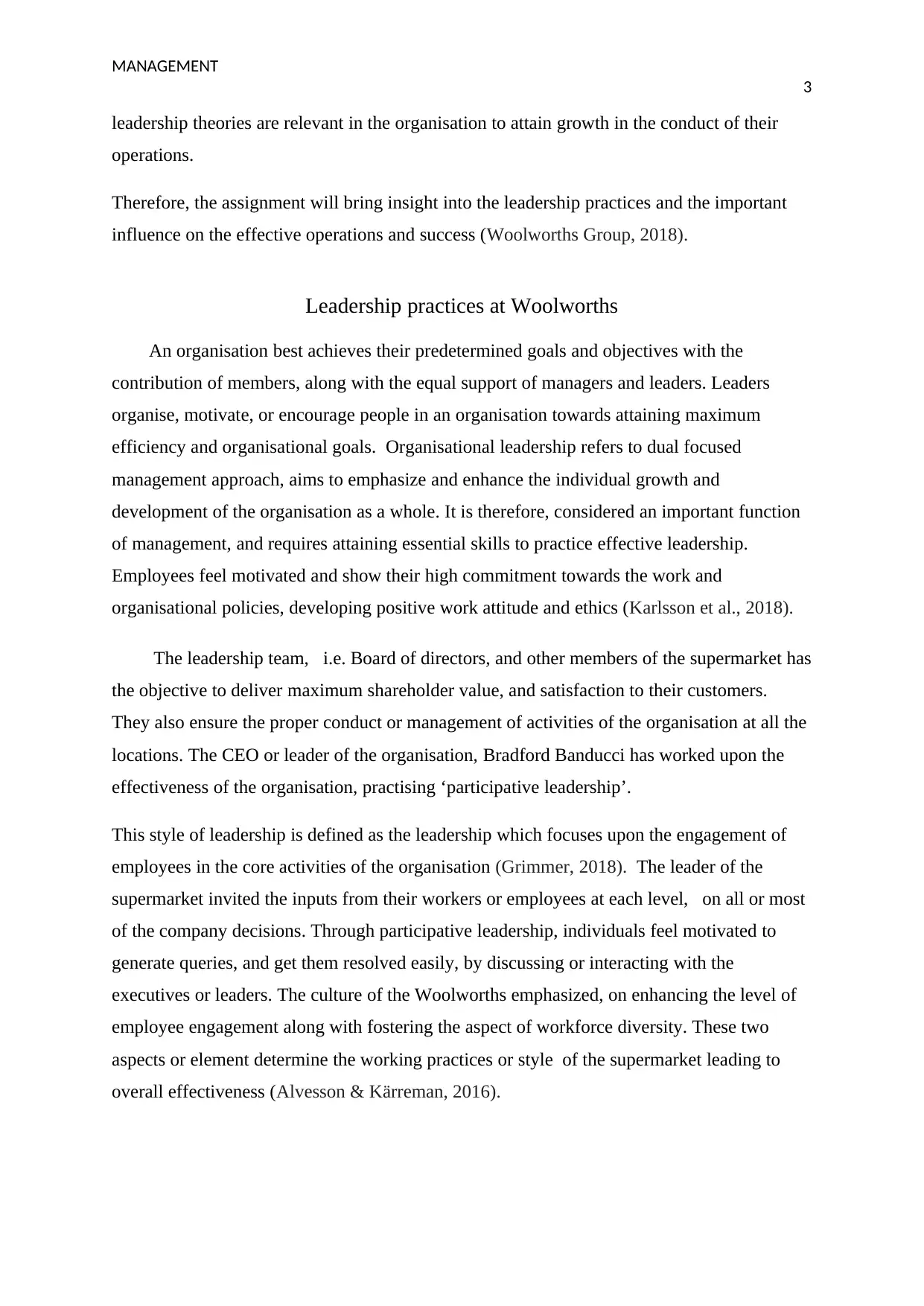
MANAGEMENT
3
leadership theories are relevant in the organisation to attain growth in the conduct of their
operations.
Therefore, the assignment will bring insight into the leadership practices and the important
influence on the effective operations and success (Woolworths Group, 2018).
Leadership practices at Woolworths
An organisation best achieves their predetermined goals and objectives with the
contribution of members, along with the equal support of managers and leaders. Leaders
organise, motivate, or encourage people in an organisation towards attaining maximum
efficiency and organisational goals. Organisational leadership refers to dual focused
management approach, aims to emphasize and enhance the individual growth and
development of the organisation as a whole. It is therefore, considered an important function
of management, and requires attaining essential skills to practice effective leadership.
Employees feel motivated and show their high commitment towards the work and
organisational policies, developing positive work attitude and ethics (Karlsson et al., 2018).
The leadership team, i.e. Board of directors, and other members of the supermarket has
the objective to deliver maximum shareholder value, and satisfaction to their customers.
They also ensure the proper conduct or management of activities of the organisation at all the
locations. The CEO or leader of the organisation, Bradford Banducci has worked upon the
effectiveness of the organisation, practising ‘participative leadership’.
This style of leadership is defined as the leadership which focuses upon the engagement of
employees in the core activities of the organisation (Grimmer, 2018). The leader of the
supermarket invited the inputs from their workers or employees at each level, on all or most
of the company decisions. Through participative leadership, individuals feel motivated to
generate queries, and get them resolved easily, by discussing or interacting with the
executives or leaders. The culture of the Woolworths emphasized, on enhancing the level of
employee engagement along with fostering the aspect of workforce diversity. These two
aspects or element determine the working practices or style of the supermarket leading to
overall effectiveness (Alvesson & Kärreman, 2016).
3
leadership theories are relevant in the organisation to attain growth in the conduct of their
operations.
Therefore, the assignment will bring insight into the leadership practices and the important
influence on the effective operations and success (Woolworths Group, 2018).
Leadership practices at Woolworths
An organisation best achieves their predetermined goals and objectives with the
contribution of members, along with the equal support of managers and leaders. Leaders
organise, motivate, or encourage people in an organisation towards attaining maximum
efficiency and organisational goals. Organisational leadership refers to dual focused
management approach, aims to emphasize and enhance the individual growth and
development of the organisation as a whole. It is therefore, considered an important function
of management, and requires attaining essential skills to practice effective leadership.
Employees feel motivated and show their high commitment towards the work and
organisational policies, developing positive work attitude and ethics (Karlsson et al., 2018).
The leadership team, i.e. Board of directors, and other members of the supermarket has
the objective to deliver maximum shareholder value, and satisfaction to their customers.
They also ensure the proper conduct or management of activities of the organisation at all the
locations. The CEO or leader of the organisation, Bradford Banducci has worked upon the
effectiveness of the organisation, practising ‘participative leadership’.
This style of leadership is defined as the leadership which focuses upon the engagement of
employees in the core activities of the organisation (Grimmer, 2018). The leader of the
supermarket invited the inputs from their workers or employees at each level, on all or most
of the company decisions. Through participative leadership, individuals feel motivated to
generate queries, and get them resolved easily, by discussing or interacting with the
executives or leaders. The culture of the Woolworths emphasized, on enhancing the level of
employee engagement along with fostering the aspect of workforce diversity. These two
aspects or element determine the working practices or style of the supermarket leading to
overall effectiveness (Alvesson & Kärreman, 2016).
Paraphrase This Document
Need a fresh take? Get an instant paraphrase of this document with our AI Paraphraser
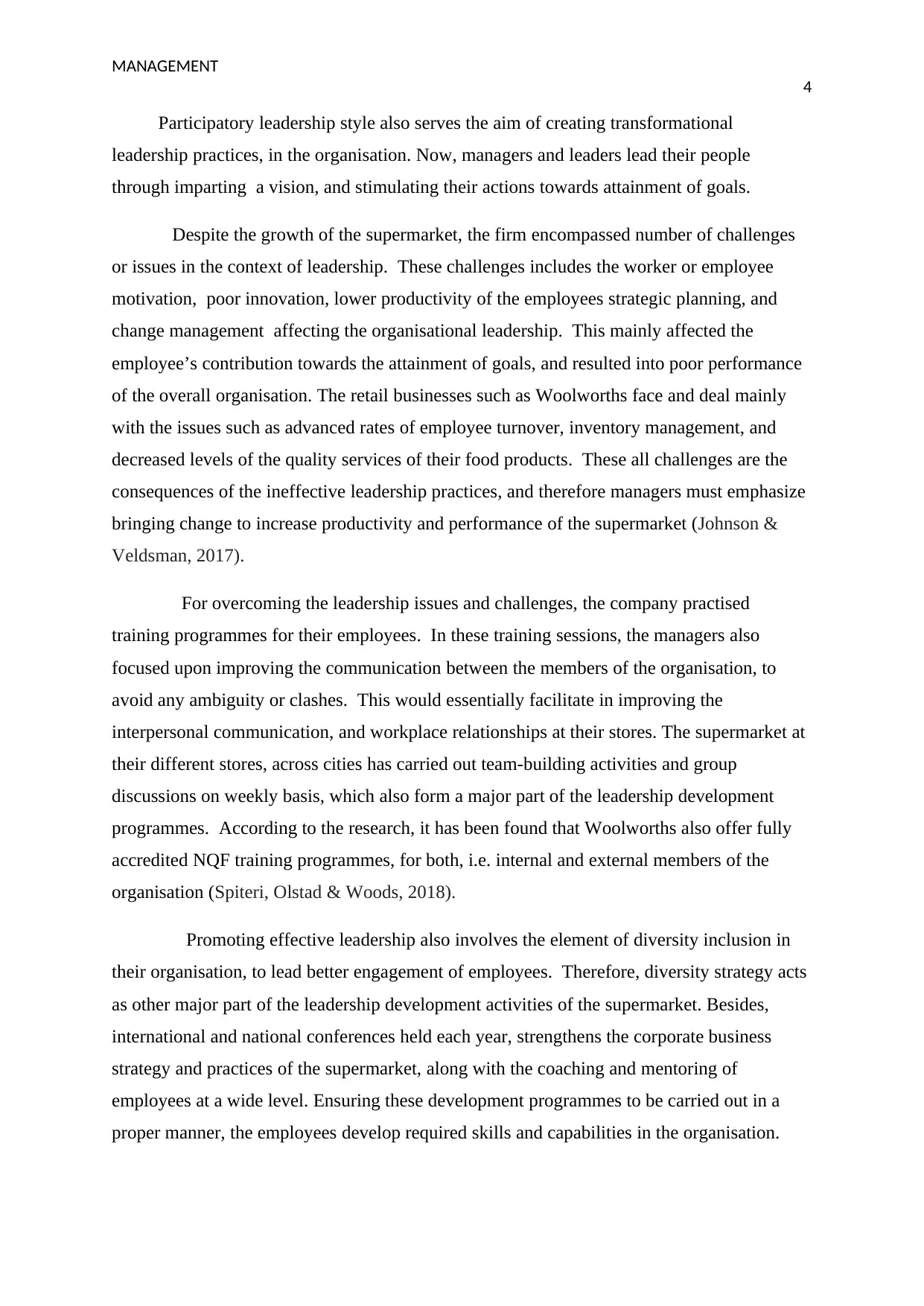
MANAGEMENT
4
Participatory leadership style also serves the aim of creating transformational
leadership practices, in the organisation. Now, managers and leaders lead their people
through imparting a vision, and stimulating their actions towards attainment of goals.
Despite the growth of the supermarket, the firm encompassed number of challenges
or issues in the context of leadership. These challenges includes the worker or employee
motivation, poor innovation, lower productivity of the employees strategic planning, and
change management affecting the organisational leadership. This mainly affected the
employee’s contribution towards the attainment of goals, and resulted into poor performance
of the overall organisation. The retail businesses such as Woolworths face and deal mainly
with the issues such as advanced rates of employee turnover, inventory management, and
decreased levels of the quality services of their food products. These all challenges are the
consequences of the ineffective leadership practices, and therefore managers must emphasize
bringing change to increase productivity and performance of the supermarket (Johnson &
Veldsman, 2017).
For overcoming the leadership issues and challenges, the company practised
training programmes for their employees. In these training sessions, the managers also
focused upon improving the communication between the members of the organisation, to
avoid any ambiguity or clashes. This would essentially facilitate in improving the
interpersonal communication, and workplace relationships at their stores. The supermarket at
their different stores, across cities has carried out team-building activities and group
discussions on weekly basis, which also form a major part of the leadership development
programmes. According to the research, it has been found that Woolworths also offer fully
accredited NQF training programmes, for both, i.e. internal and external members of the
organisation (Spiteri, Olstad & Woods, 2018).
Promoting effective leadership also involves the element of diversity inclusion in
their organisation, to lead better engagement of employees. Therefore, diversity strategy acts
as other major part of the leadership development activities of the supermarket. Besides,
international and national conferences held each year, strengthens the corporate business
strategy and practices of the supermarket, along with the coaching and mentoring of
employees at a wide level. Ensuring these development programmes to be carried out in a
proper manner, the employees develop required skills and capabilities in the organisation.
4
Participatory leadership style also serves the aim of creating transformational
leadership practices, in the organisation. Now, managers and leaders lead their people
through imparting a vision, and stimulating their actions towards attainment of goals.
Despite the growth of the supermarket, the firm encompassed number of challenges
or issues in the context of leadership. These challenges includes the worker or employee
motivation, poor innovation, lower productivity of the employees strategic planning, and
change management affecting the organisational leadership. This mainly affected the
employee’s contribution towards the attainment of goals, and resulted into poor performance
of the overall organisation. The retail businesses such as Woolworths face and deal mainly
with the issues such as advanced rates of employee turnover, inventory management, and
decreased levels of the quality services of their food products. These all challenges are the
consequences of the ineffective leadership practices, and therefore managers must emphasize
bringing change to increase productivity and performance of the supermarket (Johnson &
Veldsman, 2017).
For overcoming the leadership issues and challenges, the company practised
training programmes for their employees. In these training sessions, the managers also
focused upon improving the communication between the members of the organisation, to
avoid any ambiguity or clashes. This would essentially facilitate in improving the
interpersonal communication, and workplace relationships at their stores. The supermarket at
their different stores, across cities has carried out team-building activities and group
discussions on weekly basis, which also form a major part of the leadership development
programmes. According to the research, it has been found that Woolworths also offer fully
accredited NQF training programmes, for both, i.e. internal and external members of the
organisation (Spiteri, Olstad & Woods, 2018).
Promoting effective leadership also involves the element of diversity inclusion in
their organisation, to lead better engagement of employees. Therefore, diversity strategy acts
as other major part of the leadership development activities of the supermarket. Besides,
international and national conferences held each year, strengthens the corporate business
strategy and practices of the supermarket, along with the coaching and mentoring of
employees at a wide level. Ensuring these development programmes to be carried out in a
proper manner, the employees develop required skills and capabilities in the organisation.

MANAGEMENT
5
Thus, by engaging into these activities and making positive change, the supermarket can
attain growth in the leadership role (Аndriukaitiene et al., 2017).
5
Thus, by engaging into these activities and making positive change, the supermarket can
attain growth in the leadership role (Аndriukaitiene et al., 2017).
⊘ This is a preview!⊘
Do you want full access?
Subscribe today to unlock all pages.

Trusted by 1+ million students worldwide
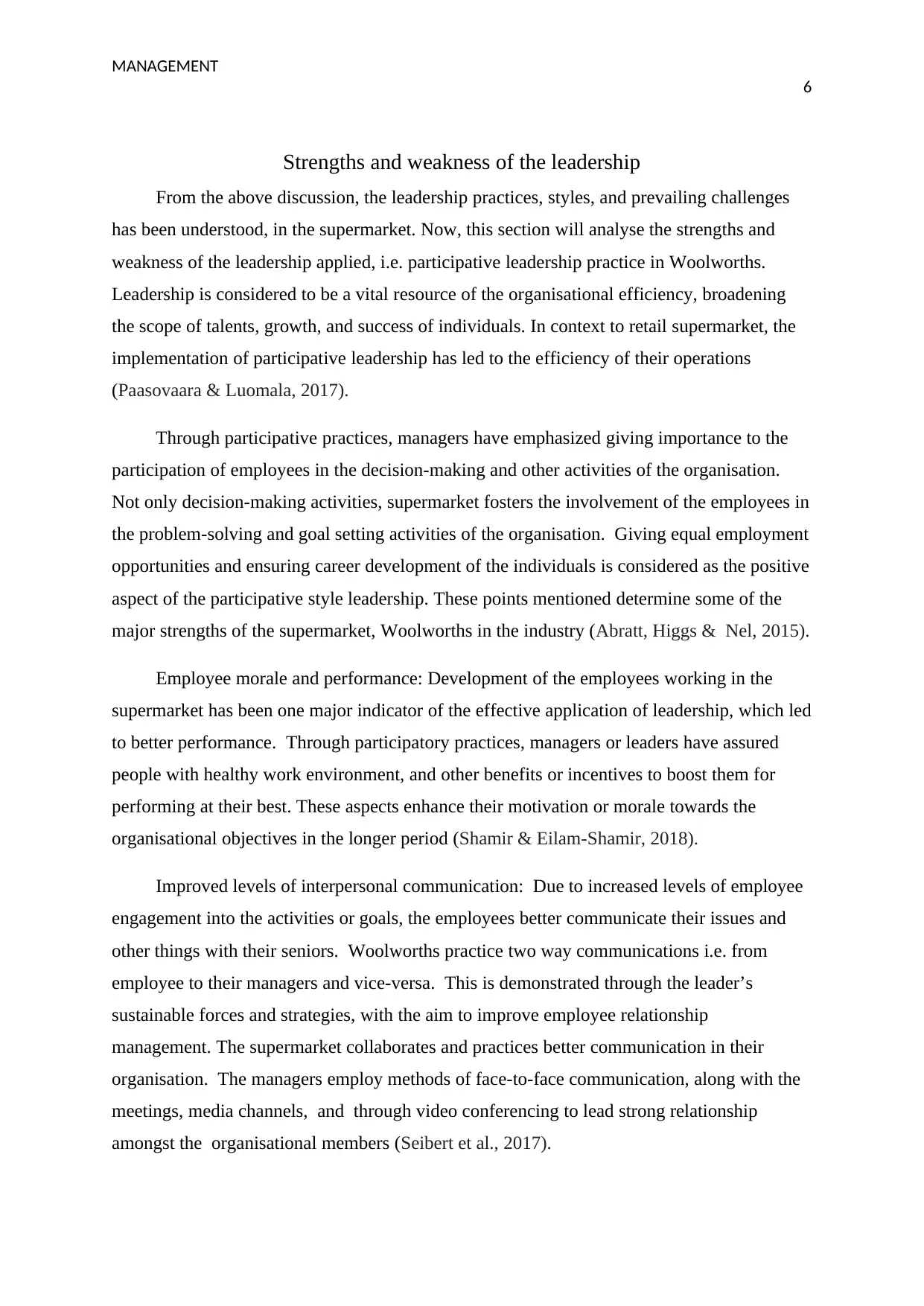
MANAGEMENT
6
Strengths and weakness of the leadership
From the above discussion, the leadership practices, styles, and prevailing challenges
has been understood, in the supermarket. Now, this section will analyse the strengths and
weakness of the leadership applied, i.e. participative leadership practice in Woolworths.
Leadership is considered to be a vital resource of the organisational efficiency, broadening
the scope of talents, growth, and success of individuals. In context to retail supermarket, the
implementation of participative leadership has led to the efficiency of their operations
(Paasovaara & Luomala, 2017).
Through participative practices, managers have emphasized giving importance to the
participation of employees in the decision-making and other activities of the organisation.
Not only decision-making activities, supermarket fosters the involvement of the employees in
the problem-solving and goal setting activities of the organisation. Giving equal employment
opportunities and ensuring career development of the individuals is considered as the positive
aspect of the participative style leadership. These points mentioned determine some of the
major strengths of the supermarket, Woolworths in the industry (Abratt, Higgs & Nel, 2015).
Employee morale and performance: Development of the employees working in the
supermarket has been one major indicator of the effective application of leadership, which led
to better performance. Through participatory practices, managers or leaders have assured
people with healthy work environment, and other benefits or incentives to boost them for
performing at their best. These aspects enhance their motivation or morale towards the
organisational objectives in the longer period (Shamir & Eilam-Shamir, 2018).
Improved levels of interpersonal communication: Due to increased levels of employee
engagement into the activities or goals, the employees better communicate their issues and
other things with their seniors. Woolworths practice two way communications i.e. from
employee to their managers and vice-versa. This is demonstrated through the leader’s
sustainable forces and strategies, with the aim to improve employee relationship
management. The supermarket collaborates and practices better communication in their
organisation. The managers employ methods of face-to-face communication, along with the
meetings, media channels, and through video conferencing to lead strong relationship
amongst the organisational members (Seibert et al., 2017).
6
Strengths and weakness of the leadership
From the above discussion, the leadership practices, styles, and prevailing challenges
has been understood, in the supermarket. Now, this section will analyse the strengths and
weakness of the leadership applied, i.e. participative leadership practice in Woolworths.
Leadership is considered to be a vital resource of the organisational efficiency, broadening
the scope of talents, growth, and success of individuals. In context to retail supermarket, the
implementation of participative leadership has led to the efficiency of their operations
(Paasovaara & Luomala, 2017).
Through participative practices, managers have emphasized giving importance to the
participation of employees in the decision-making and other activities of the organisation.
Not only decision-making activities, supermarket fosters the involvement of the employees in
the problem-solving and goal setting activities of the organisation. Giving equal employment
opportunities and ensuring career development of the individuals is considered as the positive
aspect of the participative style leadership. These points mentioned determine some of the
major strengths of the supermarket, Woolworths in the industry (Abratt, Higgs & Nel, 2015).
Employee morale and performance: Development of the employees working in the
supermarket has been one major indicator of the effective application of leadership, which led
to better performance. Through participatory practices, managers or leaders have assured
people with healthy work environment, and other benefits or incentives to boost them for
performing at their best. These aspects enhance their motivation or morale towards the
organisational objectives in the longer period (Shamir & Eilam-Shamir, 2018).
Improved levels of interpersonal communication: Due to increased levels of employee
engagement into the activities or goals, the employees better communicate their issues and
other things with their seniors. Woolworths practice two way communications i.e. from
employee to their managers and vice-versa. This is demonstrated through the leader’s
sustainable forces and strategies, with the aim to improve employee relationship
management. The supermarket collaborates and practices better communication in their
organisation. The managers employ methods of face-to-face communication, along with the
meetings, media channels, and through video conferencing to lead strong relationship
amongst the organisational members (Seibert et al., 2017).
Paraphrase This Document
Need a fresh take? Get an instant paraphrase of this document with our AI Paraphraser
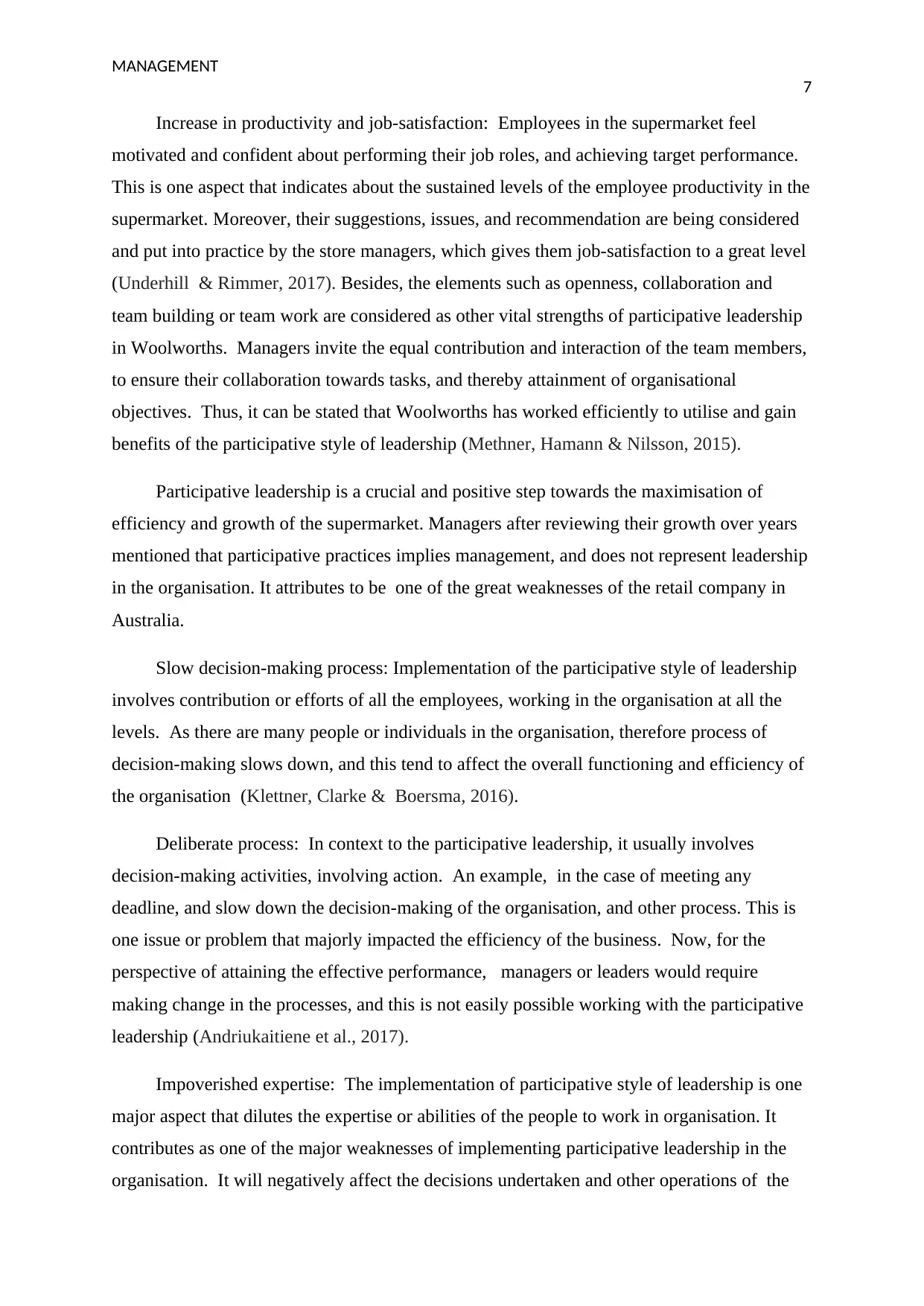
MANAGEMENT
7
Increase in productivity and job-satisfaction: Employees in the supermarket feel
motivated and confident about performing their job roles, and achieving target performance.
This is one aspect that indicates about the sustained levels of the employee productivity in the
supermarket. Moreover, their suggestions, issues, and recommendation are being considered
and put into practice by the store managers, which gives them job-satisfaction to a great level
(Underhill & Rimmer, 2017). Besides, the elements such as openness, collaboration and
team building or team work are considered as other vital strengths of participative leadership
in Woolworths. Managers invite the equal contribution and interaction of the team members,
to ensure their collaboration towards tasks, and thereby attainment of organisational
objectives. Thus, it can be stated that Woolworths has worked efficiently to utilise and gain
benefits of the participative style of leadership (Methner, Hamann & Nilsson, 2015).
Participative leadership is a crucial and positive step towards the maximisation of
efficiency and growth of the supermarket. Managers after reviewing their growth over years
mentioned that participative practices implies management, and does not represent leadership
in the organisation. It attributes to be one of the great weaknesses of the retail company in
Australia.
Slow decision-making process: Implementation of the participative style of leadership
involves contribution or efforts of all the employees, working in the organisation at all the
levels. As there are many people or individuals in the organisation, therefore process of
decision-making slows down, and this tend to affect the overall functioning and efficiency of
the organisation (Klettner, Clarke & Boersma, 2016).
Deliberate process: In context to the participative leadership, it usually involves
decision-making activities, involving action. An example, in the case of meeting any
deadline, and slow down the decision-making of the organisation, and other process. This is
one issue or problem that majorly impacted the efficiency of the business. Now, for the
perspective of attaining the effective performance, managers or leaders would require
making change in the processes, and this is not easily possible working with the participative
leadership (Аndriukaitiene et al., 2017).
Impoverished expertise: The implementation of participative style of leadership is one
major aspect that dilutes the expertise or abilities of the people to work in organisation. It
contributes as one of the major weaknesses of implementing participative leadership in the
organisation. It will negatively affect the decisions undertaken and other operations of the
7
Increase in productivity and job-satisfaction: Employees in the supermarket feel
motivated and confident about performing their job roles, and achieving target performance.
This is one aspect that indicates about the sustained levels of the employee productivity in the
supermarket. Moreover, their suggestions, issues, and recommendation are being considered
and put into practice by the store managers, which gives them job-satisfaction to a great level
(Underhill & Rimmer, 2017). Besides, the elements such as openness, collaboration and
team building or team work are considered as other vital strengths of participative leadership
in Woolworths. Managers invite the equal contribution and interaction of the team members,
to ensure their collaboration towards tasks, and thereby attainment of organisational
objectives. Thus, it can be stated that Woolworths has worked efficiently to utilise and gain
benefits of the participative style of leadership (Methner, Hamann & Nilsson, 2015).
Participative leadership is a crucial and positive step towards the maximisation of
efficiency and growth of the supermarket. Managers after reviewing their growth over years
mentioned that participative practices implies management, and does not represent leadership
in the organisation. It attributes to be one of the great weaknesses of the retail company in
Australia.
Slow decision-making process: Implementation of the participative style of leadership
involves contribution or efforts of all the employees, working in the organisation at all the
levels. As there are many people or individuals in the organisation, therefore process of
decision-making slows down, and this tend to affect the overall functioning and efficiency of
the organisation (Klettner, Clarke & Boersma, 2016).
Deliberate process: In context to the participative leadership, it usually involves
decision-making activities, involving action. An example, in the case of meeting any
deadline, and slow down the decision-making of the organisation, and other process. This is
one issue or problem that majorly impacted the efficiency of the business. Now, for the
perspective of attaining the effective performance, managers or leaders would require
making change in the processes, and this is not easily possible working with the participative
leadership (Аndriukaitiene et al., 2017).
Impoverished expertise: The implementation of participative style of leadership is one
major aspect that dilutes the expertise or abilities of the people to work in organisation. It
contributes as one of the major weaknesses of implementing participative leadership in the
organisation. It will negatively affect the decisions undertaken and other operations of the
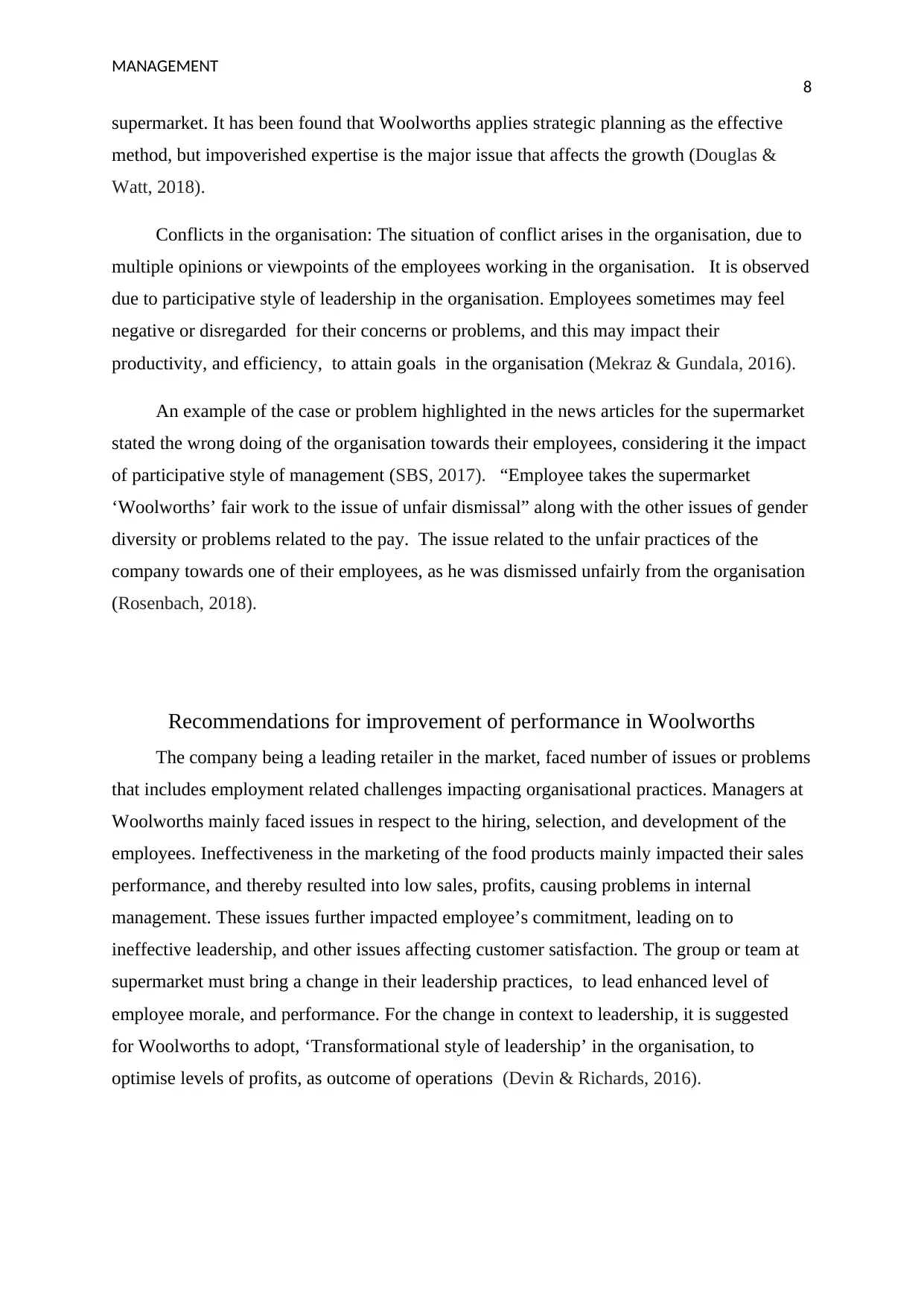
MANAGEMENT
8
supermarket. It has been found that Woolworths applies strategic planning as the effective
method, but impoverished expertise is the major issue that affects the growth (Douglas &
Watt, 2018).
Conflicts in the organisation: The situation of conflict arises in the organisation, due to
multiple opinions or viewpoints of the employees working in the organisation. It is observed
due to participative style of leadership in the organisation. Employees sometimes may feel
negative or disregarded for their concerns or problems, and this may impact their
productivity, and efficiency, to attain goals in the organisation (Mekraz & Gundala, 2016).
An example of the case or problem highlighted in the news articles for the supermarket
stated the wrong doing of the organisation towards their employees, considering it the impact
of participative style of management (SBS, 2017). “Employee takes the supermarket
‘Woolworths’ fair work to the issue of unfair dismissal” along with the other issues of gender
diversity or problems related to the pay. The issue related to the unfair practices of the
company towards one of their employees, as he was dismissed unfairly from the organisation
(Rosenbach, 2018).
Recommendations for improvement of performance in Woolworths
The company being a leading retailer in the market, faced number of issues or problems
that includes employment related challenges impacting organisational practices. Managers at
Woolworths mainly faced issues in respect to the hiring, selection, and development of the
employees. Ineffectiveness in the marketing of the food products mainly impacted their sales
performance, and thereby resulted into low sales, profits, causing problems in internal
management. These issues further impacted employee’s commitment, leading on to
ineffective leadership, and other issues affecting customer satisfaction. The group or team at
supermarket must bring a change in their leadership practices, to lead enhanced level of
employee morale, and performance. For the change in context to leadership, it is suggested
for Woolworths to adopt, ‘Transformational style of leadership’ in the organisation, to
optimise levels of profits, as outcome of operations (Devin & Richards, 2016).
8
supermarket. It has been found that Woolworths applies strategic planning as the effective
method, but impoverished expertise is the major issue that affects the growth (Douglas &
Watt, 2018).
Conflicts in the organisation: The situation of conflict arises in the organisation, due to
multiple opinions or viewpoints of the employees working in the organisation. It is observed
due to participative style of leadership in the organisation. Employees sometimes may feel
negative or disregarded for their concerns or problems, and this may impact their
productivity, and efficiency, to attain goals in the organisation (Mekraz & Gundala, 2016).
An example of the case or problem highlighted in the news articles for the supermarket
stated the wrong doing of the organisation towards their employees, considering it the impact
of participative style of management (SBS, 2017). “Employee takes the supermarket
‘Woolworths’ fair work to the issue of unfair dismissal” along with the other issues of gender
diversity or problems related to the pay. The issue related to the unfair practices of the
company towards one of their employees, as he was dismissed unfairly from the organisation
(Rosenbach, 2018).
Recommendations for improvement of performance in Woolworths
The company being a leading retailer in the market, faced number of issues or problems
that includes employment related challenges impacting organisational practices. Managers at
Woolworths mainly faced issues in respect to the hiring, selection, and development of the
employees. Ineffectiveness in the marketing of the food products mainly impacted their sales
performance, and thereby resulted into low sales, profits, causing problems in internal
management. These issues further impacted employee’s commitment, leading on to
ineffective leadership, and other issues affecting customer satisfaction. The group or team at
supermarket must bring a change in their leadership practices, to lead enhanced level of
employee morale, and performance. For the change in context to leadership, it is suggested
for Woolworths to adopt, ‘Transformational style of leadership’ in the organisation, to
optimise levels of profits, as outcome of operations (Devin & Richards, 2016).
⊘ This is a preview!⊘
Do you want full access?
Subscribe today to unlock all pages.

Trusted by 1+ million students worldwide
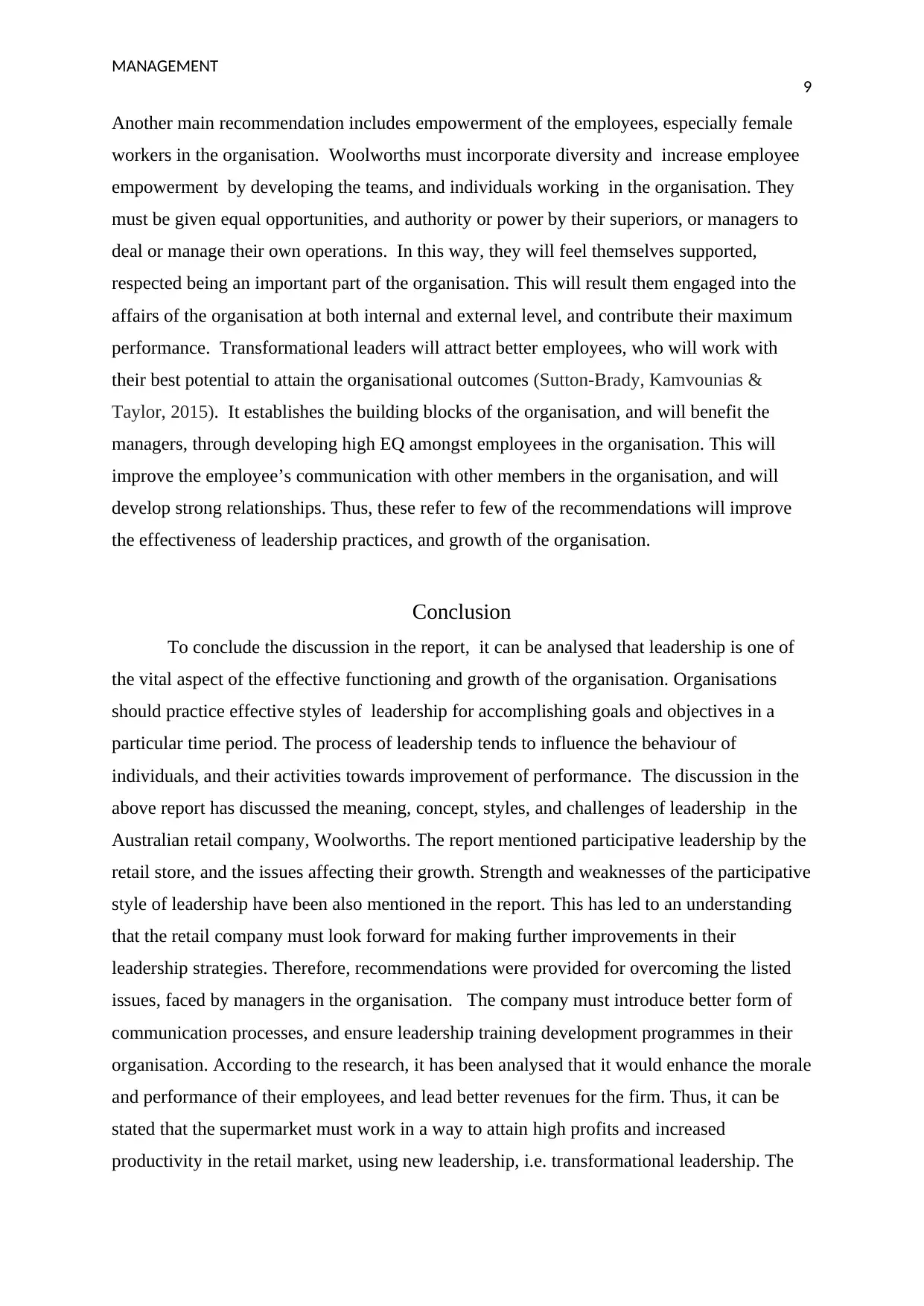
MANAGEMENT
9
Another main recommendation includes empowerment of the employees, especially female
workers in the organisation. Woolworths must incorporate diversity and increase employee
empowerment by developing the teams, and individuals working in the organisation. They
must be given equal opportunities, and authority or power by their superiors, or managers to
deal or manage their own operations. In this way, they will feel themselves supported,
respected being an important part of the organisation. This will result them engaged into the
affairs of the organisation at both internal and external level, and contribute their maximum
performance. Transformational leaders will attract better employees, who will work with
their best potential to attain the organisational outcomes (Sutton-Brady, Kamvounias &
Taylor, 2015). It establishes the building blocks of the organisation, and will benefit the
managers, through developing high EQ amongst employees in the organisation. This will
improve the employee’s communication with other members in the organisation, and will
develop strong relationships. Thus, these refer to few of the recommendations will improve
the effectiveness of leadership practices, and growth of the organisation.
Conclusion
To conclude the discussion in the report, it can be analysed that leadership is one of
the vital aspect of the effective functioning and growth of the organisation. Organisations
should practice effective styles of leadership for accomplishing goals and objectives in a
particular time period. The process of leadership tends to influence the behaviour of
individuals, and their activities towards improvement of performance. The discussion in the
above report has discussed the meaning, concept, styles, and challenges of leadership in the
Australian retail company, Woolworths. The report mentioned participative leadership by the
retail store, and the issues affecting their growth. Strength and weaknesses of the participative
style of leadership have been also mentioned in the report. This has led to an understanding
that the retail company must look forward for making further improvements in their
leadership strategies. Therefore, recommendations were provided for overcoming the listed
issues, faced by managers in the organisation. The company must introduce better form of
communication processes, and ensure leadership training development programmes in their
organisation. According to the research, it has been analysed that it would enhance the morale
and performance of their employees, and lead better revenues for the firm. Thus, it can be
stated that the supermarket must work in a way to attain high profits and increased
productivity in the retail market, using new leadership, i.e. transformational leadership. The
9
Another main recommendation includes empowerment of the employees, especially female
workers in the organisation. Woolworths must incorporate diversity and increase employee
empowerment by developing the teams, and individuals working in the organisation. They
must be given equal opportunities, and authority or power by their superiors, or managers to
deal or manage their own operations. In this way, they will feel themselves supported,
respected being an important part of the organisation. This will result them engaged into the
affairs of the organisation at both internal and external level, and contribute their maximum
performance. Transformational leaders will attract better employees, who will work with
their best potential to attain the organisational outcomes (Sutton-Brady, Kamvounias &
Taylor, 2015). It establishes the building blocks of the organisation, and will benefit the
managers, through developing high EQ amongst employees in the organisation. This will
improve the employee’s communication with other members in the organisation, and will
develop strong relationships. Thus, these refer to few of the recommendations will improve
the effectiveness of leadership practices, and growth of the organisation.
Conclusion
To conclude the discussion in the report, it can be analysed that leadership is one of
the vital aspect of the effective functioning and growth of the organisation. Organisations
should practice effective styles of leadership for accomplishing goals and objectives in a
particular time period. The process of leadership tends to influence the behaviour of
individuals, and their activities towards improvement of performance. The discussion in the
above report has discussed the meaning, concept, styles, and challenges of leadership in the
Australian retail company, Woolworths. The report mentioned participative leadership by the
retail store, and the issues affecting their growth. Strength and weaknesses of the participative
style of leadership have been also mentioned in the report. This has led to an understanding
that the retail company must look forward for making further improvements in their
leadership strategies. Therefore, recommendations were provided for overcoming the listed
issues, faced by managers in the organisation. The company must introduce better form of
communication processes, and ensure leadership training development programmes in their
organisation. According to the research, it has been analysed that it would enhance the morale
and performance of their employees, and lead better revenues for the firm. Thus, it can be
stated that the supermarket must work in a way to attain high profits and increased
productivity in the retail market, using new leadership, i.e. transformational leadership. The
Paraphrase This Document
Need a fresh take? Get an instant paraphrase of this document with our AI Paraphraser

MANAGEMENT
10
company will yield huge profits and competitive edge in the industry. Hence, Woolworths
can accomplish their goals and objectives through the aspect of positive work environment,
management strategies, and effective leadership practices.
10
company will yield huge profits and competitive edge in the industry. Hence, Woolworths
can accomplish their goals and objectives through the aspect of positive work environment,
management strategies, and effective leadership practices.
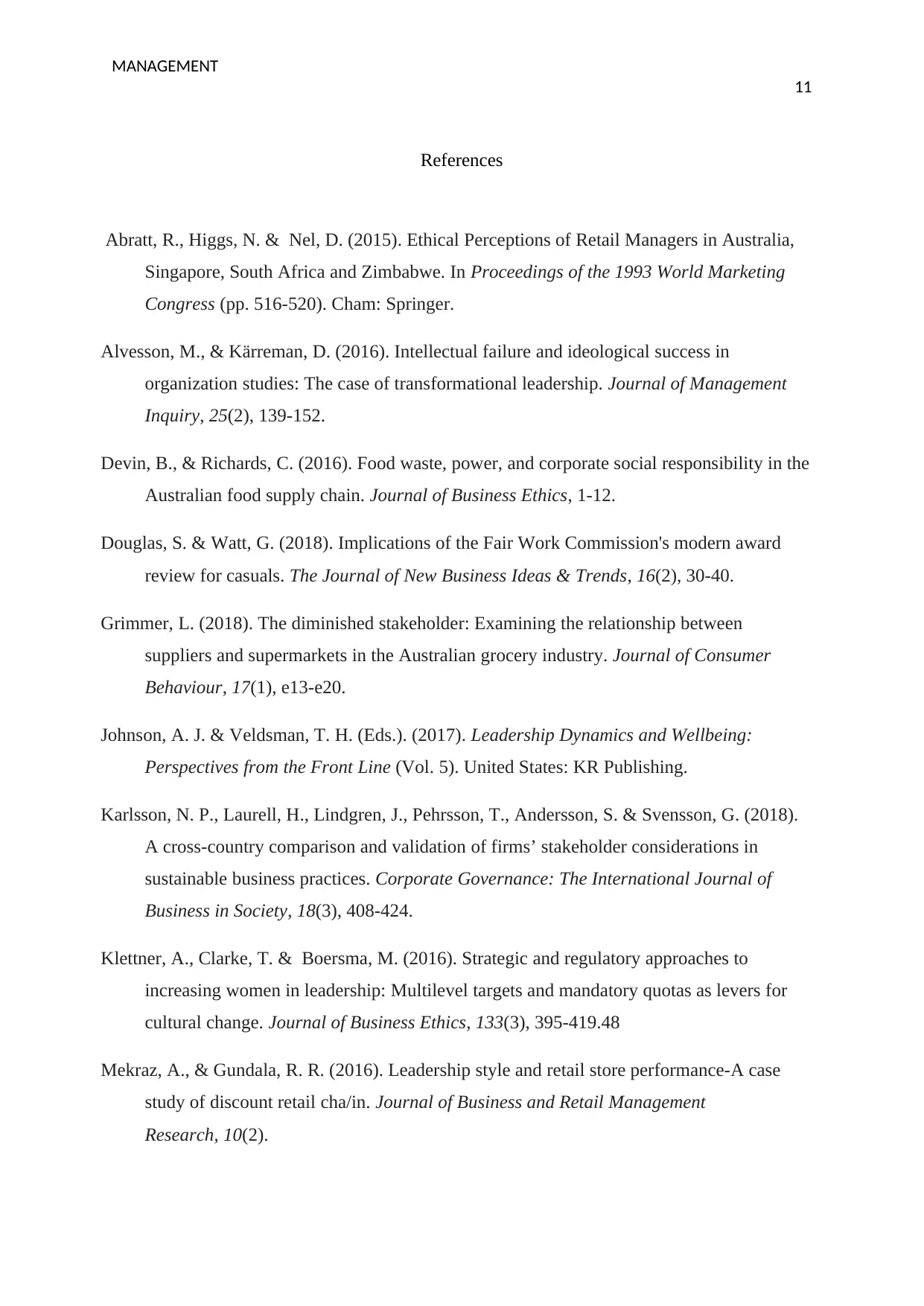
MANAGEMENT
11
References
Abratt, R., Higgs, N. & Nel, D. (2015). Ethical Perceptions of Retail Managers in Australia,
Singapore, South Africa and Zimbabwe. In Proceedings of the 1993 World Marketing
Congress (pp. 516-520). Cham: Springer.
Alvesson, M., & Kärreman, D. (2016). Intellectual failure and ideological success in
organization studies: The case of transformational leadership. Journal of Management
Inquiry, 25(2), 139-152.
Devin, B., & Richards, C. (2016). Food waste, power, and corporate social responsibility in the
Australian food supply chain. Journal of Business Ethics, 1-12.
Douglas, S. & Watt, G. (2018). Implications of the Fair Work Commission's modern award
review for casuals. The Journal of New Business Ideas & Trends, 16(2), 30-40.
Grimmer, L. (2018). The diminished stakeholder: Examining the relationship between
suppliers and supermarkets in the Australian grocery industry. Journal of Consumer
Behaviour, 17(1), e13-e20.
Johnson, A. J. & Veldsman, T. H. (Eds.). (2017). Leadership Dynamics and Wellbeing:
Perspectives from the Front Line (Vol. 5). United States: KR Publishing.
Karlsson, N. P., Laurell, H., Lindgren, J., Pehrsson, T., Andersson, S. & Svensson, G. (2018).
A cross-country comparison and validation of firms’ stakeholder considerations in
sustainable business practices. Corporate Governance: The International Journal of
Business in Society, 18(3), 408-424.
Klettner, A., Clarke, T. & Boersma, M. (2016). Strategic and regulatory approaches to
increasing women in leadership: Multilevel targets and mandatory quotas as levers for
cultural change. Journal of Business Ethics, 133(3), 395-419.48
Mekraz, A., & Gundala, R. R. (2016). Leadership style and retail store performance-A case
study of discount retail cha/in. Journal of Business and Retail Management
Research, 10(2).
11
References
Abratt, R., Higgs, N. & Nel, D. (2015). Ethical Perceptions of Retail Managers in Australia,
Singapore, South Africa and Zimbabwe. In Proceedings of the 1993 World Marketing
Congress (pp. 516-520). Cham: Springer.
Alvesson, M., & Kärreman, D. (2016). Intellectual failure and ideological success in
organization studies: The case of transformational leadership. Journal of Management
Inquiry, 25(2), 139-152.
Devin, B., & Richards, C. (2016). Food waste, power, and corporate social responsibility in the
Australian food supply chain. Journal of Business Ethics, 1-12.
Douglas, S. & Watt, G. (2018). Implications of the Fair Work Commission's modern award
review for casuals. The Journal of New Business Ideas & Trends, 16(2), 30-40.
Grimmer, L. (2018). The diminished stakeholder: Examining the relationship between
suppliers and supermarkets in the Australian grocery industry. Journal of Consumer
Behaviour, 17(1), e13-e20.
Johnson, A. J. & Veldsman, T. H. (Eds.). (2017). Leadership Dynamics and Wellbeing:
Perspectives from the Front Line (Vol. 5). United States: KR Publishing.
Karlsson, N. P., Laurell, H., Lindgren, J., Pehrsson, T., Andersson, S. & Svensson, G. (2018).
A cross-country comparison and validation of firms’ stakeholder considerations in
sustainable business practices. Corporate Governance: The International Journal of
Business in Society, 18(3), 408-424.
Klettner, A., Clarke, T. & Boersma, M. (2016). Strategic and regulatory approaches to
increasing women in leadership: Multilevel targets and mandatory quotas as levers for
cultural change. Journal of Business Ethics, 133(3), 395-419.48
Mekraz, A., & Gundala, R. R. (2016). Leadership style and retail store performance-A case
study of discount retail cha/in. Journal of Business and Retail Management
Research, 10(2).
⊘ This is a preview!⊘
Do you want full access?
Subscribe today to unlock all pages.

Trusted by 1+ million students worldwide
1 out of 14
Related Documents
Your All-in-One AI-Powered Toolkit for Academic Success.
+13062052269
info@desklib.com
Available 24*7 on WhatsApp / Email
![[object Object]](/_next/static/media/star-bottom.7253800d.svg)
Unlock your academic potential
Copyright © 2020–2025 A2Z Services. All Rights Reserved. Developed and managed by ZUCOL.



